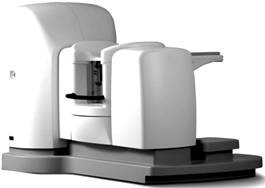by
Joan Trombetti, Writer | December 03, 2007

The ARIA Breast Imaging
System combines
mammography and
conventional ultrasound.
The largest medical meeting in the world, RSNA 2007, spotlighted exciting new technologies that are advancing imaging to unprecedented levels, as well as major scientific discoveries in diagnosis and intervention of breast cancer.
Breast Health Research Highlights
Urban Women at Risk




Ad Statistics
Times Displayed: 22487
Times Visited: 455 Stay up to date with the latest training to fix, troubleshoot, and maintain your critical care devices. GE HealthCare offers multiple training formats to empower teams and expand knowledge, saving you time and money
A study by the London Breast Institution at the Princess Grace Hospital in London, UK found that women who live in urban areas have denser breasts, making them more susceptible to developing breast cancer, yet these women are less likely to go for breast screening exams than women in outlying areas. Dr. Nicholas M. Perry and colleagues analyzed digital mammograms of 972 women from urban, suburban and rural areas. They found that women living in London had significantly denser breasts than those living outside the city, and women 45 to 54 years old had twice the risk of increased density. Age specific analyses suggested that overall differences by area were more prominent in women under the age of 50. Dr. Perry said that more research needs to be done to determine the reason for this phenomenon taking into account lifestyle factors, stress, workplace and other contributors, and he cautioned all women to go for regular breast screening. He also said that women with dense breasts should be screened with digital mammography, which is more effective at detecting cancer in dense breast tissue. In concert with this study, Miriam Sklair-Levy, MD and colleagues from Hadassah Medical Center in Jerusalem looked at the influence of the Western lifestyles on breast composition. They compared breast densities of Israeli women and Ethiopian women who immigrated to Israel and found that Ethiopian born women who immigrated to Israel had significantly lower breast density than did Israeli born women. Also, past Ethiopian immigrants who adopted a Western lifestyle (fewer children, diet changes and increased hormone use) had significantly higher breast density than recent immigrants.
FDG-PET/CT in Aggressive Cancers
Another study, by researchers at the University of Texas M.D. Anderson Cancer Center in Houston is improving chances for women who are faced with inflammatory breast cancer which is aggressive and possibly lethal within six to nine months. Using fluorodeoxyglucose positron emission tomography combined with computed tomography (FDG-PET/CT), radiologists and physicists are able to spot the spread of cancer earlier. Selin Carkaci, MD, assistant professor of diagnostic radiology at MD Anderson said that PET/CT is useful in staging inflammatory breast cancer because it provides information on both the primary disease site and disease involvement throughout the rest of the body. With FDG-PET/CT, researchers can accurately determine the location of metastases early enough so that appropriate treatment can be given. The study included 41 women with an average age of 50, who were newly diagnosed with inflammatory breast cancer. Each patient underwent a whole-body FDG-PET/CT exam. Metastases were detected in 20 patients and confirmed by biopsy and supplementary imaging. Only two false positive results were made identifying those areas as cancerous when there was no disease present resulting in a 95 percent accuracy rate. The PET/CT scans also identified cancer involvement in lymph nodes with 98 percent accuracy.

